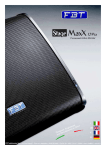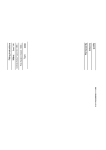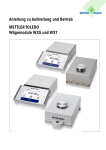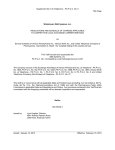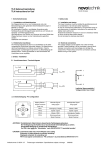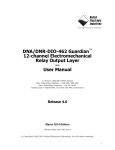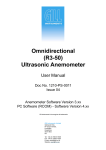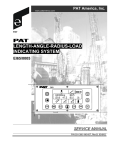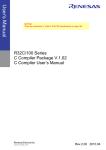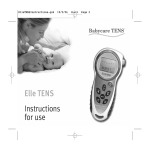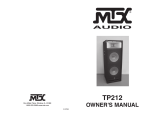Download EC Declaration of Conformity
Transcript
EC Declaration of Conformity We; Amplifier Research 160 School House Road Souderton, Pa. 18964 declare that as of 1997, our product(s); the Model 500W1000A series RF amplifiers to which this declaration relates is in compliance with the requirements of the; EEC EMC Directive (89/336/EEC) in accordance with Article 10 (2) of the directive, with the provision that the user must install the equipment as directed by the “Instructions for European EMC Conformity” in the Operating and Service Manual. This declaration is made on the basis of competent body issued EC Certificate of Conformity No.: E9 96 01 25528 015. This product(s) is in compliance with the requirements of the Low Voltage Directive (73/23/EEC) in accordance with safety standard IEC 1010-1:1990 +A1, A2. The CE marking is affixed on the device according to the EC Directives. Donald R. Shepherd President INSTRUCTIONS FOR SAFE OPERATION BEFORE APPLYING POWER Review this manual and become familiar with all safety markings and instructions. Verify that the equipment line voltage selection is compatible with the main power source. Protection provided by the equipment may be impaired if used in a manner not specified by Amplifier Research. INTENDED PURPOSES This equipment is intended for general laboratory use in a wide variety of industrial and scientific applications. It is designed to be used in the process of generating, controlling, and measuring high levels of electromagnetic Radio Frequency (RF) energy. Therefore, the output of the amplifier must be connected to an appropriate load such as an antenna or field-generating device. It is the responsibility of the user to assure that the device is operated in a location which will control the radiated energy such that it will not cause injury and will not violate regulatory levels of electromagnetic interference. HAZARDOUS RF VOLTAGES The RF voltages on the center pin of the RF output connector can be hazardous. The RF output connector should be connected to a load before AC power is applied to the amplifier. Do not come into contact with the center pin of the RF output connector or accessories connected to it. Place the equipment in a non-operating condition before disconnecting or connecting the load to the RF output connector. SAFETY GROUND This equipment is provided with a protective earth terminal. The main power source to the equipment must supply an uninterrupted safety ground of sufficient size to the input wiring terminals, power cord, or supplied power cord set. The equipment MUST NOT BE USED if this protection is impaired. PHYSICAL DAMAGE The RF amplifier should not be operated if there is physical damage, missing hardware or missing panels. MAINTENANCE CAUTION Adjustment, maintenance, or repair of the equipment must be performed only by qualified personnel. Hazardous energy may be present while protective covers are removed from the equipment even if disconnected from the power source. Contact may result in personal injury. Replacement fuses are required to be of specific type and current rating. i INSTRUCTIONS FOR SAFE OPERATION (continued) SAFETY SYMBOLS This symbol is marked on the equipment when it is necessary for the user to refer to the manual for important safety information. This symbol is indicated in the Table of Contents to assist in locating pertinent information. Dangerous voltages are present. Use extreme care. CAUTION: The caution symbol denotes a potential hazard. Attention must be given to the statement to prevent damage, destruction or harm. Indicates protective earth terminal. RANGE OF ENVIRONMENTAL CONDITIONS This equipment is designed to be safe under the following environmental conditions: Indoor use Altitude up to 2000M Temperature of 5°C to 40°C Maximum relative humidity 80% for temperatures up to 31°C. Decreasing linearity to 50% at 40°C. Mains supply voltage fluctuations not to exceed ± 10% of the nominal voltage or minimum and maximum autoranging values. Pollution degree 2: Normally non-conductive with occasional condensation While the equipment will not cause hazardous condition over this environmental range, performance may vary. COOLING AIR Care should be exercised not to block the cooling air inlets or outlets. Cooling air blockage can result in damage to the RF amplifier or intermittent shut downs. ii Instructions for European EMC Conformity WARNING It is the responsibility of the user of this equipment to provide electromagnetic shielding, filtering and isolation which is necessary for EMC compliance to Directive 89/336/EEC. The equipment must therefor be operated in a shielded area which provides a sufficient level of attenuation to meet the radiated emissions and immunity specifications. All AC, DC and Control lines connected to the equipment and entering or exiting the shielded area must have sufficient isolation to meet the conducted emissions and immunity specifications. The following minimum levels are suggested for use in accordance with the rated power of the equipment. Rated Power 100 watts 101 - 1000 watts 1001 - 10,000 watts Minimum shielding attenuation 50 dB 60 dB 70 dB Minimum line isolation 50 dB 60 dB 70 dB Since this equipment is designed to generate high levels of Radio Frequency energy, it is also essential that the user read and follow the “Instructions for Safe Operation” in this manual. If other equipment is operated in the shielded room it may be disturbed by the amplifier. ACHTUNG Der Benutzer dieses Gerätes ist dafür verantwortlich, daß die elektromagnetische Abschirmung und Filterung gewährleistet ist, welche gemäß Richtlinie 89/336/EEC notwendig ist. Das Gerät muß deshalb in einem geschirmten Raum betrieben werden, welcher eine ausreichenden Schirmung bietet, um die Emissions- und Störfestigkeitsspezifkation einzuhalten. Alle Wechsel- und Gleichspannungsleitungen sowie Steuerleitungen, die mit dem Gerät verbunden sind und in den geschirmten Raum von außen hereingeführt werden, müssen ausreichend gefiltert sein, um die Emissionsspezifkation einzuhalten. Es werden folgenden Minimalwerte der Schirmdämpfung und Filterung in den unterschiedlichen Leistungsklassen empfohlen. Hochfrequenzleistung 100 Watt 101-1000 Watt 1001-10.000 Watt min. Schirmdämpfung 50 dB 60 dB 70 dB min Filterdämpfung 50 dB 60 dB 70 dB Falls andere elektrische oder elektronische Geräte gleichzeitig mit dem Gerät betrieben werden, kann es zu Beeinflussungen kommen. Da das Gerät zur Erzeugung von Hochfrequenzenergie dient ist es daher auch unbedingt notwendig, daß der Benutzer die Sicherheitsvorschriften in der Bedienungsanleitung liest und einhält. AVERTISSEMENT Il est de la responsabilité de l'utilisateur de cet équipement d'assurer la protection électromagnétique, le filtrage et l'isolation nécessaires, afin de se conformer à la directive 89/336/EEC concernant la C.E.M. Par conséquent, cet équipement doit être mis en fonctionnement dans une enceinte d'atténuation suffisante pour satisfaire aux spécifications d'émissivité et de susceptibilité. Toutes les alimentations alternatives, continues ainsi que les liaisons de contrôle connectées à cet équipement, qui entrent ou sortent de cette enceinte doivent avoir une isolation suffisante pour satisfaire aux spécifications concernant les émissions conduites et d'immunité. Pour une utilisation conforme, les niveaux d'atténuation minimums suivants sont suggérés en fonction de la puissance de sortie de l'équipement: Puissance de sortie 100 Watts 101 à 1.000 Watts 1.001 à 10.000 Watts Atténuation minimum de l'enceinte 50 dB 60 dB 70 dB Isolation minium de la ligne 50 dB 60 dB 70 dB Puisque cet équipement est destiné à générer de forts niveaux R.F., il est essentiel que l'utilisateur se conforme aux instructions de sécurité indiquées dans ce manuel. Tout autre équipement en fonctionnement dans la cage de Faraday peutêtre perturbé par 1'amplificateur. TABLE OF CONTENTS SECTION I: GENERAL INFORMATION 1.1 1.2 1.3 1.4 1.5 1.5.1 1.5.2 General Description ..................................................................................................1-1 Specifications...........................................................................................................1-1 Power Supplies ........................................................................................................1-2 Protection Circuits....................................................................................................1-2 Installation...............................................................................................................1-2 Location ..................................................................................................................1-2 Power .....................................................................................................................1-3 SECTION II: OPERATING INSTRUCTIONS 2.1 2.2 2.3 2.4 2.5 2.6 2.7 General ...................................................................................................................2-1 Dedicated Controls and Status Indicators....................................................................2-3 Digital Control Panel (DCP) Operations .....................................................................2-8 Inputs and Outputs ................................................................................................. 2-13 Amplifier Operation................................................................................................ 2-15 Display Navigation ................................................................................................. 2-20 General Purpose Interface Bus (GPIB) Command and Status Structures..................... 2-25 SECTION III: THEORY OF OPERATION 3.1 3.2 3.3 3.4 3.4.1 3.4.2 3.5 3.5.1 3.5.2 3.5.3 3.5.4 3.5.5 3.5.6 3.6 General ...................................................................................................................3-1 Amplifier .................................................................................................................3-1 Power Supply ..........................................................................................................3-2 Control Circuits........................................................................................................3-2 Power Supply/A7 Operate Circuits.............................................................................3-2 A11 Level Control Circuits........................................................................................3-3 Fault Detection/Indicator Circuits...............................................................................3-4 Thermal Faults.........................................................................................................3-4 RF Power Faults ......................................................................................................3-5 Reference Voltage ....................................................................................................3-5 Low-Voltage Faults ..................................................................................................3-5 +20VDC Faults ........................................................................................................3-5 Amplifier Faults........................................................................................................3-5 Digital Control Panel (DCP)......................................................................................3-6 SECTION IV: TROUBLESHOOTING AND REPAIR 4.1 4.2 4.3 General ...................................................................................................................4-1 Using Indicator LEDs to Expedite Troubleshooting......................................................4-2 Replacing the Amplifier Modules ...............................................................................4-3 iv TABLE OF CONTENTS (CONTINUED) SECTION V: REPLACEABLE PARTS 5.1 5.2 5.3 5.4 5.5 5.6 5.7 Introduction .............................................................................................................5-1 Ordering Information ................................................................................................5-1 Non-Listed Parts ......................................................................................................5-1 Circuit Designators ...................................................................................................5-1 Manufacturer Abbreviation Listing.............................................................................5-3 Master List ..............................................................................................................5-3 Schematics and Bills of Material (BOMs) ...................................................................5-3 APPENDIX A: MANUFACTURERS’ ABBREVIATIONS SECTION VI: RECOMMENDED SPARE PARTS 6.1 Level of Maintenance ...............................................................................................6-1 WARRANTIES: LIMITATION OF LIABILITIES LIST OF FIGURES 1-1 2-1 2-2 2-3 2-4 2-5 2-6 2-7 2-7a 2-8 2-9 2-10 2-11 2-12 2-13 2-14 AC Line Cord Installation..........................................................................................1-3 Digital Control Panel (DCP) Features.........................................................................2-3 Rear Panel Features (Top and Bottom) ......................................................................2-5 Remote Display........................................................................................................2-6 Main Display ......................................................................................................... 2-10 Manual Display...................................................................................................... 2-10 Pulse Display ......................................................................................................... 2-10 ALC Display—Internal Mode.................................................................................. 2-11 ALC Display—External Mode................................................................................. 2-11 Typical Setup—Manual or Internal ALC .................................................................. 2-15 Typical Setup—External ALC ................................................................................. 2-17 Pulse Setup............................................................................................................ 2-19 Display Menu Tree................................................................................................. 2-20 Service Display ...................................................................................................... 2-22 Setup Display......................................................................................................... 2-22 Screen Display ....................................................................................................... 2-22 LIST OF TABLES 2-1 2-2 2-3 Relationships between Amplifier Controls and GPIB Responses ................................. 2-27 Digital Interface Com Port: Digital Interface Commands ............................................ 2-28 Digital Interface Com Port: Digital Interface Status Requests (“QUERY” Command) and Status Responses .......................................................... 2-31 v Model 500W1000A Manual Text SECTION I GENERAL INFORMATION 1.1 GENERAL DESCRIPTION The Amplifier Research (AR) Model 500W1000A is a self-contained, air-cooled, broadband, completely solid state Radio Frequency (RF) amplifier designed for applications requiring instantaneous bandwidth and high gain. Push-pull circuitry is utilized in all of the amplifier’s high-power stages to limit distortion and improve stability. When used with an RF sweep generator, the Model 500W1000A will provide a minimum of 500 watts of swept power. Special features incorporated into the Model 500W1000A include the following: • A Digital Control Panel (DCP) that allows both local and remote (via a computer interface) control of the amplifier (including adjustment of the amplifier’s RF Gain during “Manual” mode operation) and provides graphical displays of the amplifier’s Forward and Reflected power levels. • Automatic Level Control (ALC) by internal circuits or by an external input; with front panel (via the unit’s DCP) or remote (via the unit’s computer interface) control of the ALC Threshold setting. • Pulse input capability. • RF output level protection. • An internal RF detector, which provides an output for use in self-testing or operational modes. Protection is provided by DC current and voltage sensing and by the individual fusing of all RF output modules. Housed in a stylish, contemporary equipment rack, the Model 500W1000A provides readily available RF power for typical applications such as RF susceptibility testing, antenna and component testing, and wattmeter calibration; it can also be used as a driver for higher-power amplifiers. 1.2 SPECIFICATIONS Refer to the “Amplifier Research Data Sheet” on the following page for detailed specifications. 1-1 REV A Model 500W1000A 1.3 Manual Text POWER SUPPLIES The Model 500W1000A has three power supplies with a total power consumption of approximately 4000 watts. Two of these power supplies are self-contained, regulated, switching units with output voltages of 20 volts (V) and current ratings of 80 amps. The third power supply provides +24 Volts Direct Current (VDC) and -24VDC to the unit and to several voltage regulators to supply +15VDC, -15VDC, and +5VDC. Primary circuit protection is provided by circuit breakers. 1.4 PROTECTION CIRCUITS The Model 500W1000A’s protection features include RF output level protection circuits, thermal protection circuits, and internal DC level sensing and indicator circuits, along with separate fusing of the driver and final RF amplifier stages. Activation of the unit’s built-in leveling circuits—which are adjusted to approximately 575 watts Forward power and 300 watts Reflected power—will reduce gain in the low-level driver of the amplifier chain. If the leveling circuits cannot keep the amplifier’s power levels below these pre-set points, the protection circuits will initiate a shutdown of the low-level driver in the amplifier chain. A front panel RESET key allows the user to re-start the amplifier following transient DC or RF activation of the amplifier’s protection circuitry. 1.5 INSTALLATION Before installing the Model 500W10000A, thoroughly inspect the unit for signs of any physical damage that may have occurred during shipment, and read the following installation and operating instructions in their entirety. Please pay special attention to all “CAUTION” notes in this manual. CAUTION: THE LEVELING FEET LOCATED AT THE FOUR BOTTOM CORNERS OF THE MODEL 500W1000A MUST BE EXTENDED ENOUGH TO REMOVE THE WEIGHT OF THE UNIT FROM THE CASTER WHEN THE UNIT IS STATIONARY. EXTENSION OF THE LEVELING FEET WILL HELP TO PREVENT TIP -OVER AND UNDESIRED MOVEMENT. 1.5.1 Location Choose an operating location that will allow air to freely circulate into and around the unit. The Model 500W1000A is air-cooled; therefore, it must be installed in a location where the normal flow of air into or out of the unit will not be restricted, diverted, or re-circulated through the unit itself. Do not position the unit next to a wall or other equipment that could restrict the flow of air into or out of the unit. CAUTION: UNDER NORMAL OPERATING CONDITIONS, THE EXHAUST AIR TEMPERATURE FROM THE MODEL 500W1000A MAY EXCEED 32°C. DO NOT LOCATE HEAT-SENSITIVE EQUIPMENT OR PLACE BOOKS , PAPERS, OR OTHER POTENTIALLY FLAMMABLE OBJECTS OR MATERIALS ON TOP OF THE UNIT. 1-2 REV A Model 500W1000A 1.5 1.5.2 Manual Text INSTALLATION (CONTINUED) Power The Model 500W1000A is designed for a primary power input of 200–250VAC, 50/60Hz, single phase. CAUTION: DANGEROUS VOLTAGES ARE PRESENT IN THE AMPLIFIER WHENEVER IT IS PLUGGED INTO AN AC OUTLET. ALWAYS DISCONNECT THE AC POWER LINE TO THE AMPLIFIER BEFORE SERVICING THE UNIT. Due to the wide variety of power systems available internationally, no AC line cord is shipped with this unit; the user must determine and install the appropriate line cord to supply power to the unit. To install the line cord, first remove the eight screws that fasten the lower rear (fuse and power supply) panel. Carefully lay the panel down horizontally to gain access to the main breaker. Prepare an AC line cord capable of safely supplying 50 amps and insert the line cord through the Romex strain relief. See Figure 1-1 for proper connection of the wires. Tighten the Romex strain relief and reattach the lower back panel by re-installing the screws. CB1 GND STUD SAFETY GND POWER INPUT Figure 1-1 AC Line Cord Installation 1-3 REV A Model 500W1000A Manual Text SECTION III THEORY OF OPERATION 3.1 GENERAL The Model 500W1000A is a relatively simple unit to understand. The amplifier chain is a straightforward design, with a few control elements. The unit’s power supply section consists of two self-contained, replaceable, 20V switching power supplies and a +24VDC and -24VDC switching power supply that supplies 24V and also supplies voltage to the regulators that supply the remaining voltages required for operation. 3.2 AMPLIFIER Refer to Drawing Number 1009390, “Block Diagram”. From the RF input, the signal path is as follows. From the Type “N” connector on the amplifier’s front panel, the signal travels to the preamplifier-leveler, which is a self-contained, connectorized unit for ease of replacement. The RF input signal fed to a fixed 8dB attenuator (U3). This attenuator’s signal is fed to a voltage-variable attenuator (U4). The voltage-variable attenuator adjusts the maximum gain of the amplifier and is controlled by the unit’s Digital Control Panel (DCP). The next element in the preamplifier-leveler is a second voltage-variable attenuator (U5), which serves several functions. As an attenuator, it is controlled by the Automatic Level Control (ALC) circuits to control the amplifier’s RF output level as set by the Threshold Level control; it is also used by the level protection circuits to limit the amplifier’s RF output level. U5 also acts as a switch (under the control of the Pulse circuits) that controls the amplifier’s gain. The voltage-variable attenuator (U5) is followed by two self-contained hybrid amplifiers which, with the losses of the two voltage-variable attenuators, bring the gain of the preamplifier-leveler to unity. The preamplifier-leveler is powered by +15VDC and -15VDC. The next element (A3A1) is the driver amplifier module, which is located on the heat sink at the top of the unit. This amplifier has approximately 20dB of gain. It is powered by +24VDC. The next element (A3A2) is the 10-watt driver amplifier, which is also located on the heat sink and which has approximately 20dB of gain and a power output of 10 watts. The next element (A3A3) is an amplifier with 9dB of gain and capable of delivering approximately 35 watts. This amplifier module, which is powered by +24VDC and +20VDC, is used in the following stages and will be referred to as the 35-watt module throughout the remainder of this section. The output from the 35-watt module is split by a four-way splitter. The outputs of this splitter, in turn, drive four 35-watt modules. The outputs of these 35-watt modules are then split four ways each and used to drive 16 35-watt modules. The outputs of these 35-watt modules are then combined in a 16-way combiner. In other words, the final amplifier in the chain consists of 16 35-watt modules driven in parallel through their associated splitters and drivers. The output from these 16 modules is combined into one output, via a 16-way combiner. This single output then passes through a self-contained directional coupler with detectors for monitoring the amplifier’s Forward and Reflected power levels. The detected outputs are used by the ALC circuits, the fault detection circuits, and the Forward and Reflected power displays on the DCP. 3-1 REV A Model 500W1000A 3.3 Manual Text POWER SUPPLY Refer to Schematic Diagram Number 1009416, “Power Supply”. Main power to the unit is supplied to a 40-amp circuit breaker (CB1) located on the unit’s rear panel. This circuit breaker supplies line voltage to the +20VDC power supplies via FL1 and K5 on A14. Power is supplied to all of the 35-watt modules via two self-contained switching power supplies. The blower motor and the remaining power supply are powered directly by line voltage via 4-amp circuit breaker CB2. Power Supply PS3 supplies +24VDC and -24VDC to the unit and to the linear regulators located on the regulator board (see Schematic Diagram Number 1009014, “Regulator Board”) to produce +15VDC, -15VDC, and +5VDC. 3.4 3.4.1 CONTROL CIRCUITS Power Supply/A7 Operate Circuits This subsection describes the functioning of the relays and switches in the power supply assembly and the relay control board. See Schematic Diagram Number 1009391, “Functional Control Diagram.” Assume that Circuit Breakers CB1 and CB2 are closed; AC voltage is supplied to PS3, and 24VDC is applied to the DCP. The Keylock Switch must be in either the LOCAL or REMOTE position before voltage can be supplied to the rest of the amplifier. When the Keylock Switch is in either the LOCAL or REMOTE position, +5VDC is applied to one side of the Power-On Relay in the DCP. When the PowerOn Relay of the DCP is closed, a +5V signal is applied to the base of Q1 on the Regulator Board (A14). +15VDC and -15VDC are applied to the Fault Detection circuit, the Automatic Level Control (ALC) circuit, and the Preamplifier-Leveler circuit. +24VDC is supplied to the ALC circuit. If the Wiring Interlock Relay (A13K2) of the Operate Interface Board is energized, the blowers will operate and the Model 500W1000A will be in “Standby.” If the Voltage Interlock Relay (A13K4) is energized, the line voltage will be applied to the AC inputs of PS1 and PS2. The outputs of PS1 and PS2 will be turned off by grounding the “+R” terminals of these power supplies. The amplifier can now be put in the “Operate” mode if the Fault Relay (A13K3) is energized. The Operate Relay of the DCP can now complete the path and supply 24VDC to the Operate Relay in the Power Supply (A14K3). This will supply +24VDC to the amplifier modules and will remove ground from the inhibit line on PS1 and PS2, thereby allowing PS1 and PS2 to turn on. If the RF Overload Relay is energized, +24VDC will be applied to the 1-watt amplifier. Placing the unit in “Standby” will de-energize the Operate Relay, thereby removing DC voltage from the amplifier modules and the 1-watt amplifier. Various faults will cause certain functions within the amplifier to de-energize. A high Forward or Reverse power level will only turn off the 1-watt amplifier. Low-voltage power supply faults will cause the AC input to PS1 and PS2 to be removed. When the amplifier is in a “Reset” condition, pressing the RESET key on the unit’s front panel will send a “reset” signal to the fault detection board, which will attempt to clear any fault conditions that existed previously. If all faults are cleared, the amplifier may be restarted. 3-2 REV A Model 500W1000A 3.4 3.4.2 Manual Text CONTROL CIRCUITS (CONTINUED) A11 Level Control Circuits This subsection describes the operation of the Automatic Level Control (ALC) circuit board. Refer to Schematic Diagram Number 1009436, “Schematic, ALC Board,” and Schematic Diagram Number 1008651, “Schematic, Pre-Amp.” The ALC board performs the following general functions: • It provides Automatic Level Control of the amplifier’s output when the amplifier is placed in the “ALC” mode. • It limits the RF input level to the amplifier and sounds an audible alarm when the amplifier’s Forward or Reflected power levels exceed specified levels. • It sends a fault signal to the fault control board if the limiting previously described fails to control the amplifier’s Forward or Reflected power levels. This signal ultimately turns off power to the amplifier’s driver sections. • It provides voltages that are proportional to the amplifier’s Forward and Reflected power levels to the DCP, and it provides a DC voltage that is proportional to the amplifier’s Forward power level to the DETECTED OUTPUT connector. A pulse input signal from the PULSE INPUT connector is also used to provide pulsed RF output from the amplifier. Voltages are received from the directional coupler, which is located in series with the amplifier’s RF output, that are proportional to the amplifier’s Forward and Reflected power levels. These voltages are amplified by U1 to provide +1.0VDC at U1, Pin 1 with an output power of 500 watts. The Forward Opamp (U1A) provides the input to Amplifier U2, which provides four separate outputs to each of the following: the Internal ALC circuit, the DETECTED OUTPUT connector, the Forward power display on the DCP, and the level protection circuits. The Reflected Opamp (U1B) also drives a quad buffer amplifier (U5), which drives the Forward and Reflected power displays on the DCP and the level protection circuitry (U7). The level protection circuitry driven by U2 and U5 is diode “ored” to provide input to Opamp U6. This opamp, in turn, is the input to the audio alarm comparator (U15), which turns on when the amplifier’s Forward power exceeds approximately 600 watts or when the amplifier’s Reflected power exceeds approximately 300 watts; it also drives the Forward/Reflected power comparator, which sends a signal to the fault control board, which ultimately causes DC power to be turned off to the amplifier’s driver section. This amplifier (via diode CR6) also drives the input to U11, which controls a Voltage-Variable Attenuator (U5) in the Leveler-Preamplifier assembly. The ALC circuitry takes its input from either the internal source U2A, via an electronic switch (U13) or from either the DETECTED INPUT (+) or DETECTED INPUT (-) connectors on the unit’s front panel (External ALC). One of these voltages drives U14, depending upon the polarity of the detected voltage. 3-3 REV A Model 500W1000A 3.4 3.4.2 Manual Text CONTROL CIRCUITS (CONTINUED) A11 Level Control Circuits (continued) The threshold of the amplifier’s output power is determined by the threshold reference voltage from the DCP. The threshold voltage supplies a reference voltage input to Pin 13 of integrated circuit (IC) U8. The ALC gain is adjustable by the digital potentiometer (U4), which is followed by a stage of gain (U16), which drives U11, which controls the Voltage-Variable Attenuator (U5) in the A2 Leveler-Preamplifier assembly, thereby completing the ALC loop. The pulse input controls the Voltage-Variable Attenuator (U5) in the A2 Leveler-Preamplifier assembly to provide pulsed control of the amplifier via Q3, Q4, and the strobe input of U11. Electronic switch U13 selects the signal to be used to provide Automatic Level Control (ALC) of the amplifier’s output: Internal ALC, ALC with External Detector (+), or ALC with External Detector (-). Electronic switch U9 controls the ALC time constant by selecting various values (from 0.1–330 µf) of the capacitors located in the feedback of the amplifier (U3). 3.5 FAULT DETECTION/INDICATOR CIRCUITS This subsection describes the function and theory of the Model 500W1000A’s fault detection and fault indicator circuits. The Model 500W1000A’s THERMAL, AMPLIFIER, and VOLTAGE fault indicator and VOLTAGE ONLINE indicator LEDs can be accessed by opening the amplifier’s hinged door. Refer to Schematic Diagram Number 1009423, “Fault Control Board,” and Schematic Diagram Number 1005957, “W Series Module. 3.5.1 Thermal Faults A thermal switch is located on each of the amplifier’s heat sinks and on the final output combiner. These switches are normally closed; they open when the temperature exceeds a pre-determined value, causing a voltage to appear on the input to the fault control board. These inputs are latched and turn on LEDs DS7 through DS13, thereby indicating which switch has opened. The latch circuits (for example, examine the input on J1-1 from A-3) consist of a set-reset flip-flop (U2-A and U2-D). U1 ensures that the initial failure that caused the latch to be set has been cleared. Amplifier heat sink thermal faults are “ored” via U3-A, U13-A, U12-A, U3-B, and U17-D to control the output of Q21, which in turn controls the fault relay. When activated, the fault relay turns off all voltages to the RF amplifiers. The combiner thermal faults are “ored” via U9-B and U10-A to control the output of Q7, which in turn controls the RF overload relay. This relay controls the power to the A3A1 driver amplifier module. 3-4 REV A Model 500W1000A 3.5 3.5.2 Manual Text FAULT DETECTION/INDICATOR CIRCUITS (CONTINUED) RF Power Faults The fault control board receives a signal from the ALC board in the event that the amplifier’s Forward or Reflected power has exceeded specified limits. This signal is received on J1-15 and latched by U8 and indicated by LED DS-14. The output from this latch, in turn, causes the overload relay to be activated via U9-B, U10-A, and Q7. This causes the power to the A3A1 driver amplifier module to be turned off. 3.5.3 Reference Voltage A +4.8VDC reference voltage is generated on the fault control board. This voltage is used as the reference for all voltage comparisons made by the fault control board’s circuits. This voltage is developed by regulating the +15VDC on the fault control board to +4.8VDC. The regulator consists of opamp U20 and reference Zener diode VR1 and is calibrated by adjusting potentiometer R82. 3.5.4 Low-Voltage Faults The low-current power supplies enter the fault board via J2, Pins 1–12. DS15, DS16, DS18, and DS19 indicate that the voltages are present at the test points. The +4.8VDC reference voltage is used by comparators U7-A, U7-B, U7-D, U19-C, and U19-D to determine if any of the low-current power supplies are in a low-voltage condition. The output from these comparators is in turn “ored” by U13-B, U13-C, and U13-D to form a single output. This output then controls the output of Q7 via U10-A and Q20 via U17-A. Q7 controls the RF overload relay, which turns off DC power to the A3A1 driver module. Q20 controls the voltage interlock relay, which enables power to be applied to the amplifiers. 3.5.5 +20VDC Faults The voltages from the +20VDC switching power supplies input to the fault control board on J2, Pins 13 and 14. DS20 and DS21 indicate that the voltages are present at the test points. Note that these voltages are only on when the amplifier is in the “Operate” mode. The +20VDC power supplies are subjected to a high-voltage limit by comparators U19-A and U19-B. The comparator outputs are latched by U18-A, U18-B, U18-C, and U18-D. Faults are indicated by DS28 and DS27. The latched outputs are then “ored” by U3-B and control the output of Q20 via U17-A and Q21 via U17-D. Q20 controls the interlock relay, and Q21 controls the fault relay. 3.5.6 Amplifier Faults Refer to Schematic Diagram Number 1005957, “W Series Module.” The RF sensing board’s inputs (e.g., Pins 2 and 3 of U1) are derived from the voltage developed across the collector current sense resistors of the 35-watt amplifier modules. When this voltage goes to a high-voltage, low-current condition the output of the opamp swings positive causing current to flow through diode CR1. Diodes CR1, CR3, CR5, and CR7 form an “or” network that feeds current through LED DS1. This LED indicates a fault in the amplifier module. 3-5 REV A Model 500W1000A 3.5 3.5.6 Manual Text FAULT DETECTION/FAULT INDICATOR CIRCUITS (CONTINUED) Amplifier Faults (continued) The output from each LED in an amplifier is interconnected to “or” the fault currents from each amplifier block (heat sink). These six outputs in turn are connected to the fault control board (J1, Pins 9–14). At this point, the inputs are diode “ored” into one input. The diodes that form these groups are LEDs and thus also indicate which heat sink has a fault. These inputs form the input to current comparators, formed by U6, Q2, and U7-B. The current comparator has only one output, which is active in the event of a failure in either the driver or final amplifiers. A fault will activate the RF overload relay via U9-B, U10-A and Q7. This turns off DC power to the driver amplifiers. A fault signal is received from the ALC board in the event that the forward or reflected power limits of the amplifier has been exceeded. This signal enters the fault board on J1-15 and is latched and controls the RF overload relay via U9-B, U10-A, and Q7. This fault turns off DC power to the driver amplifiers. The fault control board’s latches can be reset by one of three conditions occurring. The RESET switch on the front panel is closed or the OPERATE switch or the POWER switch is pushed. Either of these conditions causes the voltage at the collector of Q11 or Q12 to go to a low state. 3.6 DIGITAL CONTROL PANEL (DCP) This subsection provides a brief description of the theory of operation of the Model 500W1000A’s Digital Control Panel (DCP). For a complete functional description of the DCP, refer to Section II of this manual (“Operating Instructions”). Refer to AR Block Diagram Number 1008442 and Da-Tech Wiring Diagram Number 30C2317. The DCP contains a programmed microprocessor and three programmed microcontrollers to read panel control settings and create panel displays. It interfaces to functional parts of the amplifier via standard interface lines and levels from the amplifier interface printed wiring board (PWB), plus a dedicated “INHIBIT” line from the Keylock Switch. The DCP contains one parallel port (a General Purpose Interface Bus (GPIB)) and one serial port. The DCP uses +28VDC for primary power and to power the amplifier interface. Communication between the DCP’s components and the amplifier interface is via a (serial) fiber-optic link pair. This link is designed so that data transfer is halted when errors are detected. All errors detected on this link are displayed as a COM ERROR on the DCP’s Liquid Crystal Display (LCD). 3-6 REV A Model 500W1000A Manual Text SECTION IV TROUBLESHOOTING AND REPAIR CAUTION: EXTREME CAUTION SHOULD BE EXERCISED WHEN TROUBLESHOOOTING THIS UNIT, PARTICULARY WHEN MEASURING VOLTAGES IN THE POWER SUPPLY SECTION, AS HAZARDOUS VOLTAGES EXIST IN THE UNIT THAT COULD CAUSE SERIOUS INJURY TO PERSONNEL PERFORMING SUCH MEASUREMENTS . 4.1 GENERAL The Model 500W1000A should require very little maintenance, since it is a relatively simple instrument. It is built with printed wiring boards (PWBs) and solid state devices that should ensure long, trouble-free life. However, should trouble occur, care must be taken when servicing the unit to avoid damaging the PWBs and the solid state devices. Since the amplifier’s solid state components are soldered in place, substitution of components should not be resorted to unless there is some indication that they are faulty. In addition, take care when troubleshooting not to short voltages across the amplifier. Small bias changes may damage the amplifier due to excessive dissipation or transients. Components within Amplifier Research instruments are conservatively operated to provide maximum instrument reliability. In spite of this, parts may fail. Usually, the instrument must be immediately repaired with a minimum of down time. A systematic approach can greatly simplify, and thereby speed up, repair. Incorporated into the Model 500W1000A are fault control and detection circuits. Included in these circuits are indicator LEDs that can greatly expedite troubleshooting of the unit. For a description of how these indicators can be used to assist in troubleshooting the unit, see subsection 4.2, “Using Indicator LEDs to Expedite Troubleshooting.” To enable rapid repair of the unit, certain parts which are the most likely to fail during the life of the unit, are shipped with the unit as spares. For use and installation of these parts see the appropriate subsection of this section. Due to the critical importance of maintaining the amplifier’s alignment, it is recommended that the unit be returned to the factory for part replacement and amplifier realignment when failure is caused by a breakdown of any of the components in the RF signal circuits (with the exception of the 35-watt modules, when a replacement module, as shipped with the unit, is available). Shipping instructions are as follows: Ship the unit PREPAID via Motor Freight to: Amplifier Research Corporation 160 School House Road Souderton, PA 18964-9990 USA 4-1 REV A Model 500W1000A 4.2 Manual Text USING INDICATOR LEDS TO EXPEDITE TROUBLESHOOTING CAUTION: EXTREME CAUTION SHOULD BE EXERCISED WHEN TROUBLESHOOOTING THIS UNIT, PARTICULARY WHEN MEASURING VOLTAGES IN THE POWER SUPPLY SECTION, AS HAZARDOUS VOLTAGES EXIST IN THE UNIT THAT COULD CAUSE SERIOUS INJURY TO PERSONNEL PERFORMING SUCH MEASUREMENTS . The Model 500W1000A incorporates relatively sophisticated fault detection and fault indicator circuitry. The unit’s THERMAL, AMPLIFIER, and VOLTAGE fault indicator and VOLTAGE ONLINE indicator LEDs can be accessed by opening the hinged door on the front of the amplifier. Use of these indicator LEDs can usually expedite troubleshooting of the amplifier. If the RESET LED is lit (red), the first step should be to turn off RF power to the unit and press the RESET key to see if the fault clears. If the fault clears, slowly bring the amplifier’s drive level back up and ensure that RF power levels are not exceeded. If the fault does not clear with the RF drive off, some other problem probably exists in the amplifier. Open the hinged door on the amplifier’s front panel to access the indicator LEDs and test points; note any red LEDs that are lit. At the same time, examine the rear fuse panel to see if any of the fuse indicator LEDs are lit. Following are some examples of how these indicator LEDs can be used to expedite troubleshooting. 4.2.1 Power Supply Faults A lit voltage LED on the fault control board indicates that one of the power supplies has fallen below specification. A quick look at the power indicator LED board will indicate if one or more of the supplies has failed completely. (Note: The +20VDC power supplies will not be on unless the unit is in the “Operate” mode). Test points are available on the voltage supply board to measure directly the auxiliary voltages. A faulty condition of any of these voltages could be caused by a failure of the power supply itself or by one of the circuits it powers drawing too much current. A lit fuse indicator LED indicates that one of the amplifier modules has drawn too much current. A lit +20V “A” or “B” LED on the fault control board indicates that one of the +20VDC switching power supplies was in an over-voltage condition. 4.2.2 Thermal Faults A lit thermal LED on the fault control board is probably an indication of a fan failure for that particular heat sink. 4-2 REV A Model 500W1000A 4.2 4.2.3 Manual Text USING INDICATOR LEDS TO EXPEDITE TROUBLESHOOTING (CONTINUED) Amplifier Fault A lit AMPLIFIER FAULT LED indicates that one of the amplifier modules has failed or that its in-line fuse has blown. Visual examination of the modules themselves will indicate which module has failed; the failed module’s fault indicator LED will be lit. 4.2.4 RF Overload As stated previously, an RF overload condition can usually be corrected by reducing the RF input to the unit. 4.3 REPLACING THE AMPLIFIER MODULES CAUTION: POWER TO THE UNIT MUST BE TURNED OFF BEFORE PERFORMING ANY REPAIR WORK; THIS SHOULD BE DONE BY UNPLUGGING THE UNIT FROM THE LINE VOLTAGE SOURCE. FAILURE TO DISCONNECT THE UNIT FROM THE LINE VOLTAGE SOURCE PRIOR TO SERVICING WOULD PRESENT A HAZARD TO SERVICE PERSONNEL AND COULD RESULT IN DAMAGE TO THE AMPLIFIER. If, after troubleshooting, it has been determined that one of the 35-watt modules has failed, the following procedure should be followed if a matched module to the unit is available. (The spare 35-watt module that was shipped with the unit is matched to the unit). 4.3.1 Turn off the power to the unit. Unplug the power supply cord and/or open the circuit breakers on the unit’s rear panel. CAUTION: WHEN CONNECTING OR DISCONNECTING ANY SEMI-RIGID COAXIAL CABLE, EXTREME CAUTION MUST BE EXERCISED IN ORDER TO ENSURE THAT THE CABLE IS NOT DISTORTED FROM ITS ORIGINAL SHAPE. ANY SUCH DISTORTION OF THE COAXIAL CABLE’S SHAPE COULD ADVERSELY AFFECT THE AMPLIFIER’S PERFORMANCE . THESE CABLES VARY IN LENGTH, AND THEIR LENGTH IS CRITICAL TO THE AMPLIFIER’S PERFORMANCE; IF A CABLE MUST BE REPLACED, THE NEW CABLE MUST BE OF THE SAME LENGTH AS THE ORIGINAL CABLE. CABLES SHOULD NOT BE INTERCHANGED. 4-3 REV A Model 500W1000A 4.3 4.3.2 Manual Text REPLACING THE AMPLIFIER MODULES (CONTINUED) Disconnect the RF cables to the unit by using an appropriate wrench. CAUTION: WHEN DISCONNECTING THE DC POWER SUPPLY WIRES TO THE FAILED AMPLIFIER MODULE , BE SURE TO NOTE IN SOME MANNER (E.G ., STICK-ON LABELS) WHERE THESE WIRES WERE ORIGINALLY CONNECTED TO THE AMPLIFIER MODULE. THE DC POWER SUPPLY WIRES MUST BE CONNECTED TO THE REPLACEMENT AMPLIFIER MODULE IN EXACTLY THE SAME MANNER; FAILURE TO DO SO WILL DAMAGE THE NEW AMPLIFIER MODULE . 4.3.3 Disconnect the DC power supply wires to the failed amplifier module. 4.3.4 Remove the output transistor mounting screws. 4.3.5 Remove the PWB mounting screws and remove the failed amplifier module. CAUTION: DO NOT IGNORE THE FOLLOWING STEP . FAILURE TO PERFORM THE FOLLOWING STEP WILL DAMAGE THE AMPLIFIER’S OUTPUT TRANSISTORS. 4.3.6 Apply a light coating of thermal grease to the mounting flanges of the transistors on the replacement amplifier module. 4.3.7 Align the replacement amplifier module over the heat sink mounting holes and loosely install all of the mounting screws for the amplifier module and the transistor flanges. Carefully tighten the transistor flange screws; do not completely tighten one side of the flange before tightening the other side, as this may warp the flange or place undue stress on the transistor. 4.3.8 Connect the coaxial cables and the power supply wires to the replacement amplifier module in the same manner as they were connected to the original amplifier module. 4-4 REV A




















